August 18, 2007
Eaglespeak posts a superb piece on a really neat and innovative semisubmersible torpedo boat the USN designed during the Civil War.
This is a warship I'd heard about but never gotten details on...the diagram is really neat and explains a lot!
Thank you Eaglespeak!
Note that as far as semisubmuribility, this vessel was actually predated by RSC Naugatuck, also briefely known as the E.A.Stevens. While not exactly stealthy, interservice rivalry absolutely demands that she be mentioned.
Naugatuck (spelling?) was a test rig for the abortive 'Stevens Battery', a large ironclad begun in the 1850's. Due to design changes and navy skepticism, the vessel was under construction for more han a decade, and was never completed.
Naugatuck was intended to test two main features of the larger ship, semi-submuribility and an autoloading mechanism. The vessel could trim down awash to reduce her target and gain a bit of protection. She could also load her gun from a protected barbette below decks and shoot it at enemy targetswith minimal crew exposure.
The vessel was reasonably successful but as it as not intended to be more than a test bed, and because of the flakieness of the builder, the USN (which then had Galena, New Ironsides, and Monitor under construction) did not buy it.
The vessel was purchased by the Revenue Cutter Service, given extemporised armor and pressed into service in the civil war.
The vessel was in action on both revenue, and blockade duties and engaged the CSS Virginia (Merrimack) two days after her more famous engagement with USS Monitor and was in action against Confederate shore batteries at the battle of Dreweys Bluff, where her telescoping parrot rifle exploded. Despite this she handled the enemy fire far better than Galena.
In part because her propulsion plant was COTS and easy to maintain, Naugatuck served in the RCS until 1872.
I believe she was also the first RCS cutter that Michael Healy was assigned to.
Sadly, I have no design specs handy as I'm in Japan and information on the vessel seems sparse. 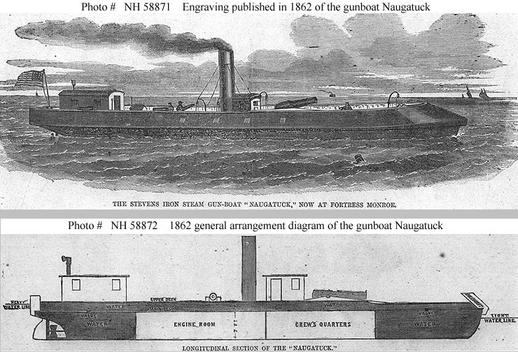
Posted by: The Brickmuppet at
08:29 AM
| No Comments
| Add Comment
Post contains 352 words, total size 2 kb.
July 28, 2007
CGX has been in the pipe for some time, but this article mentions a much larger vessel also being contemplated.
The other new cruiser would be a much larger, 25,000-ton nuclear-powered ship with a more conventional flared bow, optimized for the ballistic missile defense (BMD) mission.
This is certainly interesting and there is more on it here.
25,000 tons is in the ballpark of the size of most historical dreadnoughts. This is a BIG ship if built.
Here is an accurate representation of what such a ship will almost certainly not look like.

This seems at first blush like good news but a total of 19 ships (14 of the CGX and 5 of these very large ships) is not going to replace 27 no matter how capable ones ship is. The finest ship in the world is no good if it is not present and cutting the numbers of ships reduces both the chances that a US vessel will be present, and makes it less possible to make good losses.
While the size of the vessels in question should not have a great bearing on costs (steel is cheap compared to the electronics that make up most of the cost of warships today) adding nuclear power will, in all probability, cause costs to cascade exponentially.
With only 5 contemplated, their utility will be limited and it might be better to build more similarly sized conventionally powered ships.
Of course the flip side of this is that the Navy does need to cut its dependence on oil and this program may be a way to jump start that transition.
The propulsion plant contemplated seems to be a semi off-the shelf "half carrier" plant which makes sense but is disappointing.
Now USN nuclear plants have had amongst the best safety records in the world since the late 1950s, but if they are going to spend this much money (and nuclear ships are hella-expensive) then they might as well go with a newer reactor design like the naval thorium reactor proposed here. This could potentially be a boon for both civilian and naval affairs if very safe compact reactors were developed from this. Of course boondogalage is rampant in government financed programs so I'd suggest they simply offer a prize for a satisfactory design.
That is unlikely to happen and there are other concerns as well.
The Democratic congress which is generally not a fan of defense spending of any sort, lukewarm at best to nuclear power, and vehemently opposed to Ballistic Missile Defense...is now pressuring the Navy to build a nuclear powered ballistic missile defense ship....Oh and they are going to reccomend canceling the improved naval Anti Ballistic missile missile while they are at it...
They also say the analysis will recommend dropping the Kinetic Energy Interceptor (KEI) from the CG(X) program.
The KEI is a large ballistic missile-defense rocket under development by Northrop Grumman as a ground- or sea-based weapon to intercept ballistic missiles in their boost, ascent and midcourse flight phases.
The KEI is much larger than the SM-3 Standard missile developed by Raytheon to arm Navy cruisers and destroyers for the BMD role. The 40-inch diameter KEI is nearly 39 feet long, while the 21-inch diameter SM-3 stands just over 21 feet tall. Both missiles use a kinetic energy warhead, intended to ram an enemy missile.
Sources said a missile launch tube for a KEI would need to be so large it would take the place of six SM-3 launch cells.
This seems like blinkered logic to me.The Evolved SeaSparrow Missile can be quadpacked into a standard vertical launch cell...see...

....so there seems to be little reason that six regular sized cells (or their analogues) could not be substituted for one of these KEI missiles if greater combat persistence against non-ballistic or super high flying targets were required. (The big tube might be adaptable for a big bombardment rocket as well). This cuts the future missile defense capability and puts most of the missile defense eggs into a very expensive 5-ship basket that seems prone to the sort of cost overruns and cancellations that have plagued US naval procurement of late.. So one can be forgiven for looking this gift horse in the mouth.
Anyway, I'm a big fan of nuclear power, I want the navy to have good ships, and ship size is not in and of itself a major cost driver and has tremendous advantages in survivability, effectiveness, and availability (read seakeeping). However I'm not convinced...especially given the issues facing the similar but theoretically less ambitious DDX program ...that this proposal is terribly well thought out....It certainly has potential but needs a bit of scrutiny.
Update:
For those unclear on the concept of "cruisers" all is explained at this excellent site that discusses cruisers in general and gives a very good overview of what cruisers are and arent. It also has some very interesting bits on two cancelled projects from the late 80's early 90s.
For those interested in maritime applications for and challenges to atomic power check out this long and comprehensive report.
Thanks to Dr. Crouch for making it public and Kirk Sorensen for pointing it out.
Full Disclosure: this whole post is waaay beyond my paygrade.
Posted by: The Brickmuppet at
08:17 PM
| No Comments
| Add Comment
Post contains 892 words, total size 7 kb.
July 14, 2007
The cost overruns of the LCS eat at the raison d’être of the whole program, a light cheap fast (expendable) combatant. Note though that the LCS is still vastly cheaper than it's big brother, the DD1000.
The DD 1000 is the size of a small Battleship* and cost about as much as a BB would. Yet these vessels are being pitched as destroyers, and their vapourware half sisters, the CG21,are to replace the DDs and CGs in the escort role....apparently by replacing the big guns with missile tubes and adding a better air defense system...which promises to push the cost up even higher.
The LCS is cheap for a destroyer, but has the armament of an OPV. It has all sorts of potential for improvement by adding various modules, but none of these give it any area defense capability, or any capability for surface combat beyond the 30 click range of the as yet non-operational NLOS missiles. With their big flex deck, impressive helicopter capability and good seakeeping they might make useful auxiliaries but they are an insanely expensive solution to all the problems they are intended to tackle and little more than toothless coffins for their crews in a hot war.
In response to this, as I pointed out on the old blog in April, there is an upgraded design being offered by General Dynamics see here , here and here.
One would assume that similar options would be available for the currently defunct LockMart design. One would be right.
This part time Coasties suggestion?
Scrap DD1000.
For fire support use ATACMS fired from VLS tubes, and develop the POLAR missile...a ship based derivative of the off the shelf MLRS system that the Navy rejected in the 90s. (but give it the unitary warhead of the current GMLRS). Buy something in the class of these 2 designs as replacements. Get ferocious about cost discipline. Buy as many of them as possible.Most importantly, buy enough modules, particularly ASW modules, that the ships really are multi mission. Numbers are what the navy needs...but it needs numbers of vessels that can take care of themselves. This strikes me as a far better compromise than the high-low mix as the low end vessels tempt the congresscritters to count them as full on units.
*The USNs first Dreadnoughts, the South Carolina and Michigan were 16,000 tons.
Posted by: The Brickmuppet at
05:07 PM
| No Comments
| Add Comment
Post contains 411 words, total size 4 kb.

It looks like (and the consensus of opinion seems to be that it is) a fake gun mount intended to deter maritime brigands.
While the Perrys have lost virtually ALL of their hot war punch with the removal of the MK 13 missile launchers, they still possess both a MK 75 76mm gun and an improved Phalanx upgraded to improve its effectiveness against surface targets. The ship is quite capable of dealing with pirates and such...of course neither the phalanx nor the 3inch gun look particularly fierce to an untrained eye, and at any rate the ship seems to have no weapons bearing forward aside from small arms and, perhaps .50 caliber weapons on the bridge wings.
So what IS this thing, a dummy gun to deter attackers, or an actual weapon like a 25-30mm cannon?
It certainly looks fake.
(Note: At time of posting there is a much better high res picture in the linked thread...)
As an aside, the USCG's 378' High endurance cutters now have the same fixed armament and have it better positioned, comparable range and speed, twin screws, better maneuverability and a shallower draft....and despite being twice as old with old and hard to maintain equipment, require a crew of 168 vs 300 . The Perrys certainly have better EW equipment, 2 vice 1 helicopters and their ASW tubes are still fitted, but it is hard to avoid thinking that the Coast Guard, with something similar to the 378's would be better (and more economical) to use on antipiracy duties.
Of course....we'd need to not have our new-builds be lemons first.
Perhaps we should just build more of the 'white needles of death' with updated systems (you know...systems still in production).
Anyway, does anyone have any contradictory ideas on the "dummy gun"?
Posted by: The Brickmuppet at
01:24 PM
| No Comments
| Add Comment
Post contains 319 words, total size 3 kb.
June 28, 2007
For the second time in as many weeks ACE posts a seriously interesting revolver pic.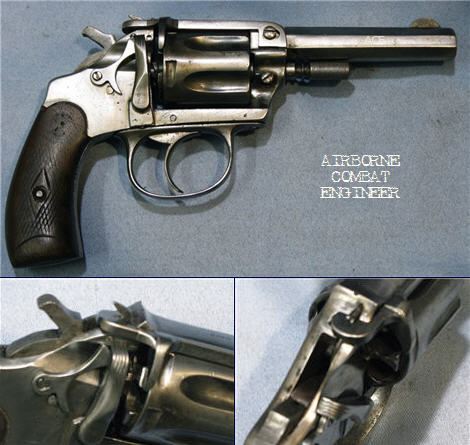
No I have no idea what it is yet, but reading the comments, it seems this thing can actually extract the cases as they are fired!
That's unheard of in a revolver. If this were to work, it would make a good police or defensive firearm. One could top off ones cylinder like one can top off a weapon with a tube magazine, like a pump gun. This would be very good in a lot of tactical situations.
Of course...given the general lack of these things filling gun store shelves, there is likely something I'm missing.
Posted by: The Brickmuppet at
12:58 AM
| Comments (5)
| Add Comment
Post contains 115 words, total size 1 kb.
June 25, 2007
One of the challenges facing the USCG is replacing the medium endurance cutters. The Reliance class are decent ships that have served well beyond their anticipated life, but...they are thus quite old are slow, bad rollers and spares for their engines must be obtained from South Africa, or hand made here. The Bear class are only about 10 years younger, are bad rollers and slow, (though they are robust vessels still in good condition) that both classes have given such good service is, at this point, a testament to their crews rather than their design.
Replacing these is a daunting and expensive prospect, as is manning them. The new offshore patrol cutter currently under development has a crew of 91 plus an air group. Note that given the issues with the new high endurance cutters, the USCG may be going back to the drawing board with these vessels.
Ideally a medium endurance cutter should have a helicopter for fast transit to a SAR search area and to extend the ships horizon. It should be fast, have good endurance and excellent sensors. It should have a large capacity for rescuees. Aside from the last requirement, these criteria can be met by this old design. It is a 330 page pdf file of a 1980 study on airships by the USCG using the technology of the day.
In the late '80s the Coast Guard rented a Skyship from the UK for tests and it was considered quite succsessful. In the early 90s an improved version, the Sentinel 1000, was being tested for the Navy and Coast Guard, but it was destroyed when the airship hangar in Weeksville NC burned, ending the program.
An airship has several advantages, it has far greater endurance than a helicopter, it is almost as fast, ( 60-90kts depending on the design) it can carry a large surveillance radar, it can hover longer...( for days if needed) compared to a patrol boat or WMEC it is at least twice as fast. Airships actually can deal with storms fairly well, (the USNs K-class airships served in the north Atlantic, some of the worst weather on the planet, yet they only lost one...which was destroyed by gunfire from a U-boat).
Today there are several designs to choose from, the old Zeppelin company is back in the rigid airship business with their innovative Zeppelin NT design, that uses steerable thrust to lower ground crew to 3! 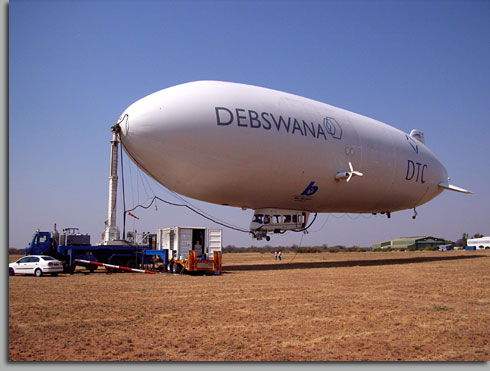
Skycat of the UK is offering an amphibious lifting body design specifically geared to costal patrol and surveillance, perhaps inspired by the recent US Army tests with another UK design, the Lightship. Heck, even Blackwater security is getting into the airship business! Thus this is NOT unproven technology.
Given that it can't carry hundreds of rescuees, is not going to break ice and is not going to carry buoys, it is not a replacement for all surface vessels, but for polar science research, general law enforcement , search and rescue, ice patrol and surveillance, these craft have awesome potential as force multipliers. It has the reach, horizon and very nearly the speed of a helicopter operated from a medium endurance cutter, with far more time on scene and the crew and fuel expenses of a patrol boat!
For Naval applications AEW and ASW airships have already proved their worth. Regards ASW in particular a larger design might well fill a niche that seems to have atrophied somewhat in the USN. The Army is already looking into them for surveillance and communications relays and Army and humanitarian organizations might find them useful for mine clearance in postwar theaters, especially if they're fitted with ground penetrating radar or other advanced sensors...
But as a coastie, my primary interest is as a cost effective asset to the Coast Guard, and I really think something of this type is an excellent and cost effective means of increasing reach and reducing response time at a limited cost.
I think it certainly bears further investigation.
Posted by: The Brickmuppet at
02:36 AM
| No Comments
| Add Comment
Post contains 673 words, total size 5 kb.
June 24, 2007
The US Coast Guard was very interested, it was EXACTLY the right size, speed and range for them, but the senior sea service could not afford enough to make production viable for Bell, they tried to interest the other services for a bulk buy....the other services decided that an enlarged version would be a perfect fit for them and the V22 was ordered....the prototype was spectacularly successful so makin' it bigger should be cheap right?
Well no....
At least part of the problems stemmed from the fact that the mechanics of the thing did not scale up easily. The original plane, who's outstanding success had inspired its trouble plagued stepchild languished as investors shied away...put off by the V22s myriad problems and the single crash of an XV 15 around 1992.
Now, according to this Defense Tech article, Bell has entered into a joint production agreement with Augusta and a polished version of the XV 15 is entering production as the Bell Augusta 609.
Here is video from the DT Article...with really crappy music.
More on the Bell Augusta 609 from no less an impartial source that the Bell/Augusta marketing department here.
Global Security has a page on the currently apocryphal HV609 here.
An admittedly cursory Google search turns up little beyond marketing. The history of the Coast Guard and the XV15 was related to me by an officer who had previously been an airdale and participated in the program.
I would hope that the CG could get a lot of these as they would seem to fit their mission requirements quite well, but the fact that the first deliveries are not scheduled until 2011 may be a deal breaker, the USCG needs aircraft NOW as its current fleet is hard pressed.
Still one can hope.
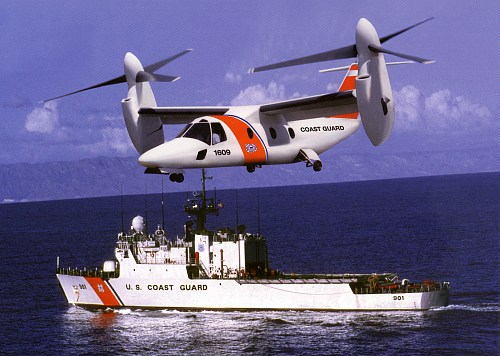
Posted by: The Brickmuppet at
09:31 PM
| No Comments
| Add Comment
Post contains 329 words, total size 2 kb.
June 17, 2007
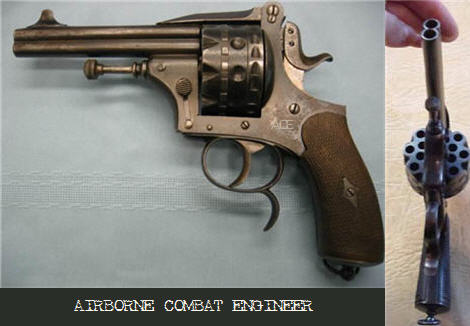
What in the hell?
A 16+shot double barreled revolver!? And how does one unload it? ThereThere is a little pin at the forward end of the cylinder, that hints at an extractor rod, but it doesn't look like a break top or swing out cylinder. If it were a muzzle loader there should be a rammer or something.
One of the commenter's mentions a Lefaucheux revolver, which it does bear a similarity to...but damn this is a weird one.
Pete? Astro?
Posted by: The Brickmuppet at
07:59 PM
| Comments (5)
| Add Comment
Post contains 104 words, total size 1 kb.
June 13, 2007
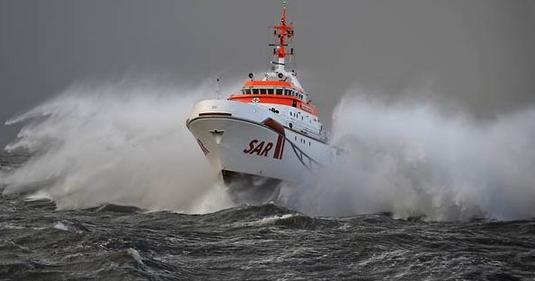 The 'Seenotkreuzer' Herman Marwede of the German Sea Rescue Service plows through heavy seas in the Skaggerak during a training exercise.
The 'Seenotkreuzer' Herman Marwede of the German Sea Rescue Service plows through heavy seas in the Skaggerak during a training exercise. Despite being only 45 meters long, the ship is claimed to be capable of maintaining 25 knots in sea state 5.
The US Coast Guard is currently looking for patrol boats of about the same size, they could do far worse than fitting this one with uprated engines and a few guns.
An informative article on this vessel is here (German text).
Note the Babblefish translation keeps talking about "ship throwing" or "ship tossing" ....of course they mean 'launching'...this makes more sense but I was disappointed to realize that no trebuchet was involved.
Posted by: The Brickmuppet at
09:57 PM
| No Comments
| Add Comment
Post contains 116 words, total size 1 kb.
June 10, 2007
here, here, here, here and here.
The Result:
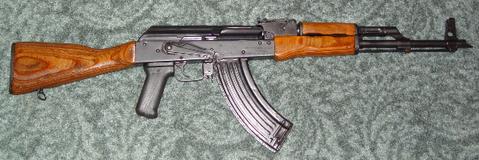
Posted by: The Brickmuppet at
02:25 PM
| Comments (1)
| Add Comment
Post contains 17 words, total size 1 kb.
29 queries taking 0.0188 seconds, 102 records returned.
Powered by Minx 1.1.6c-pink.









